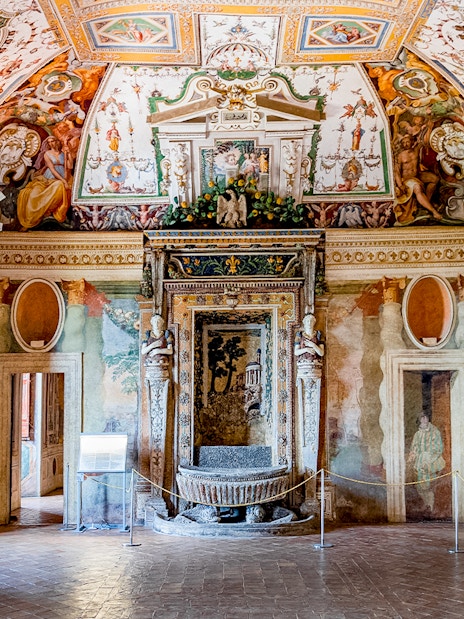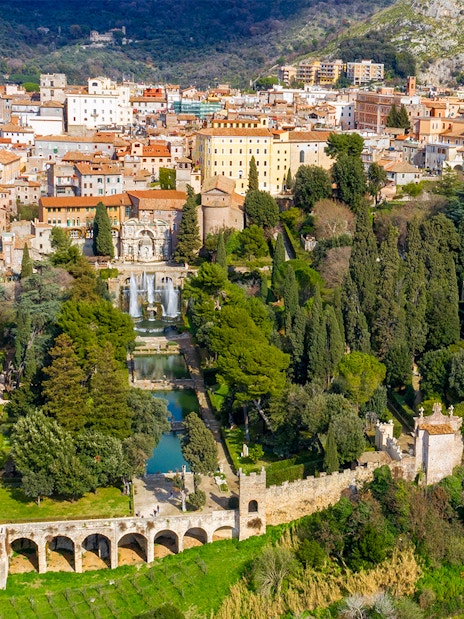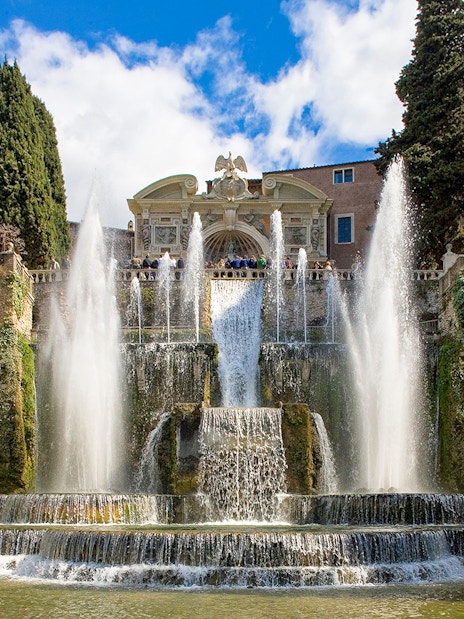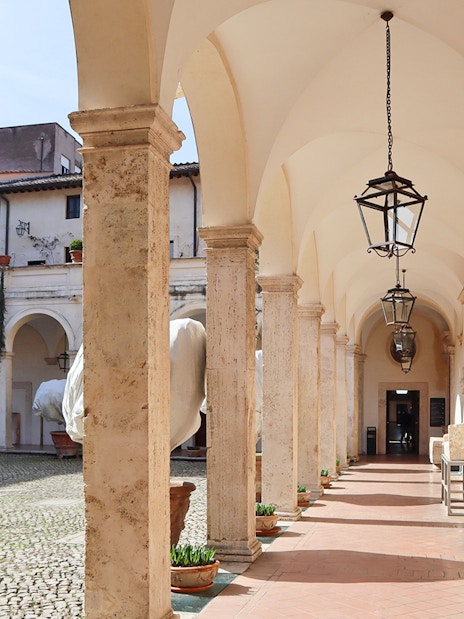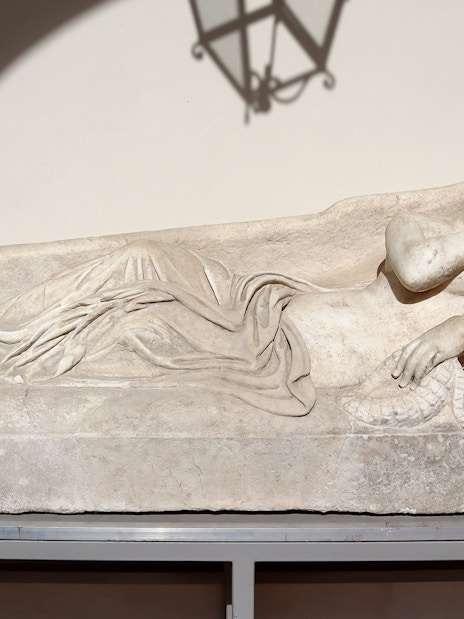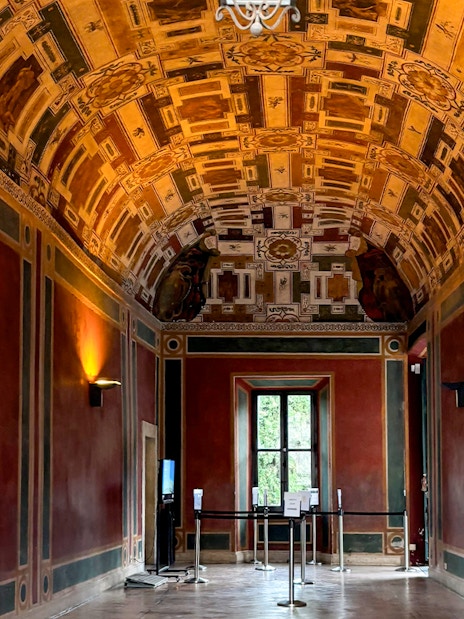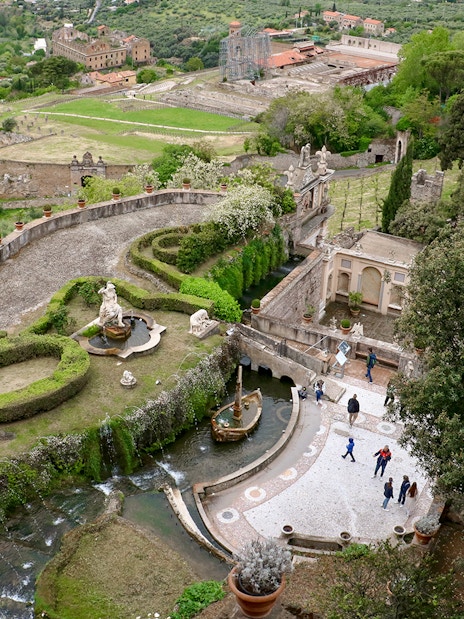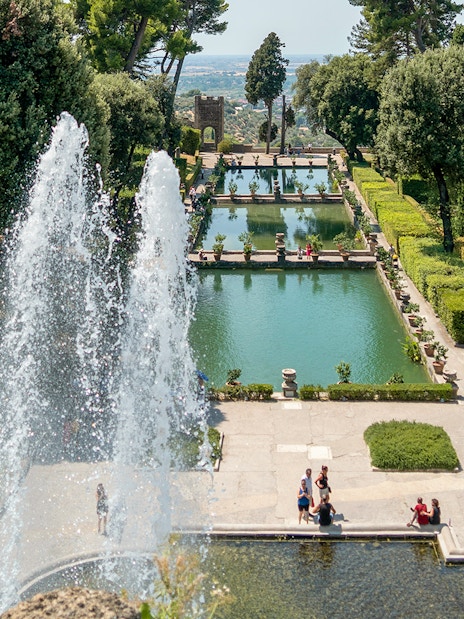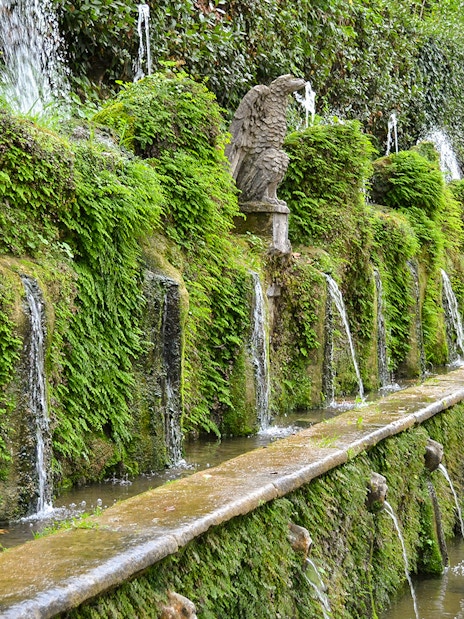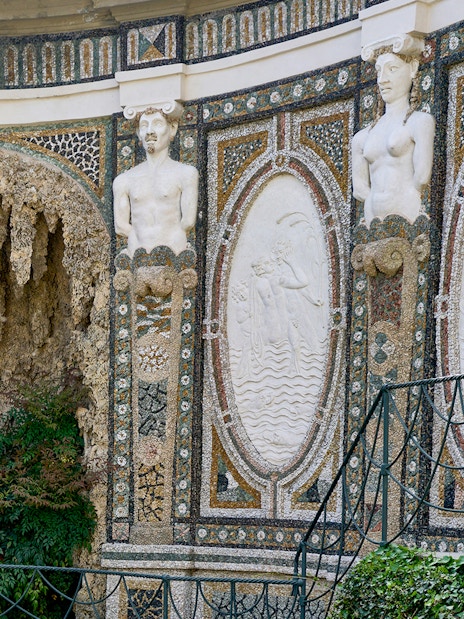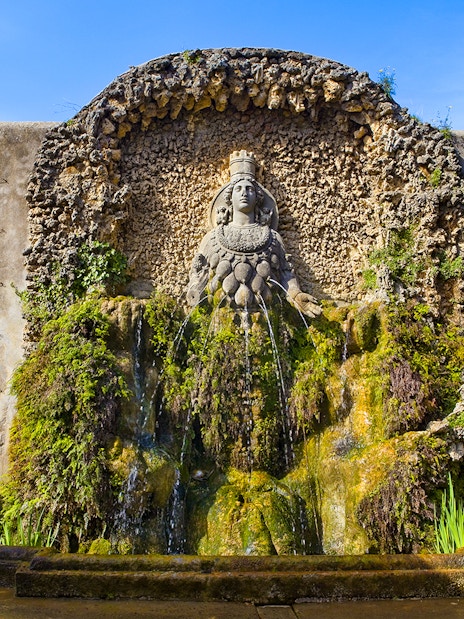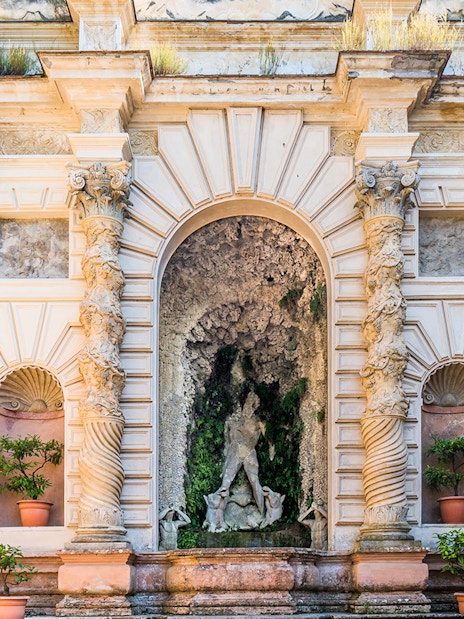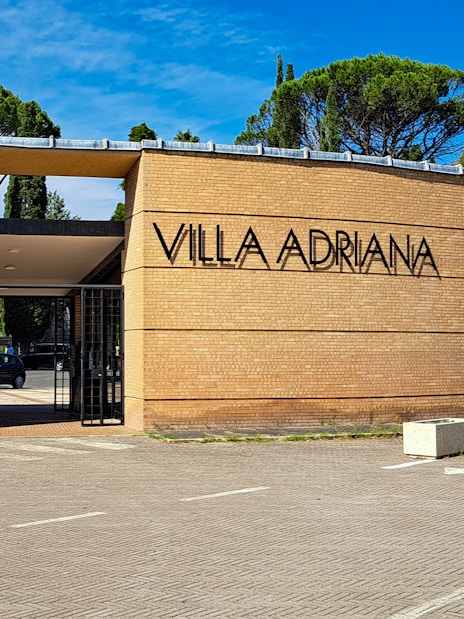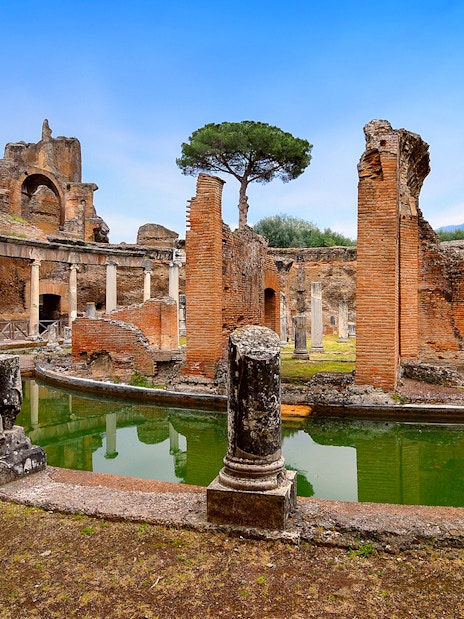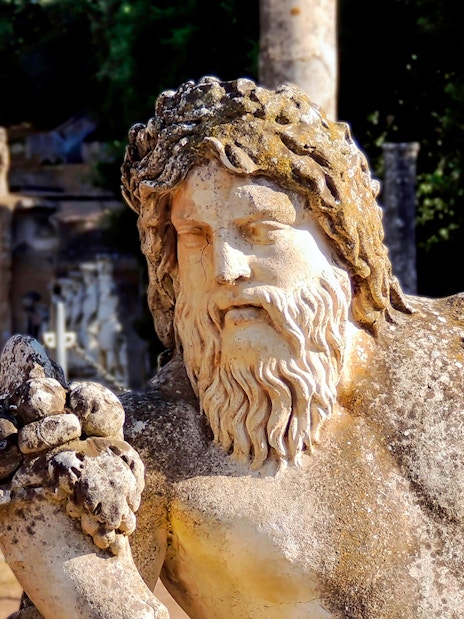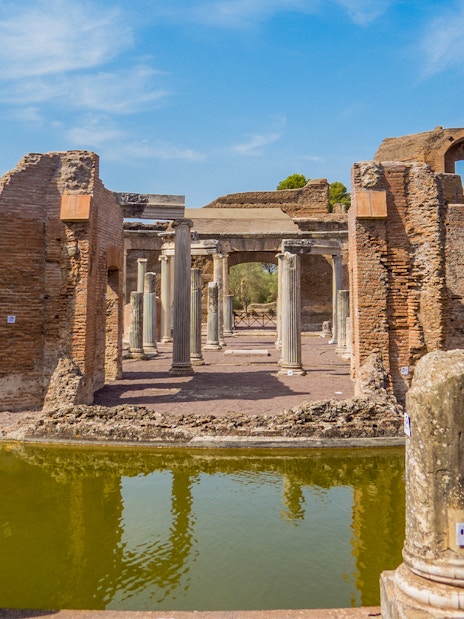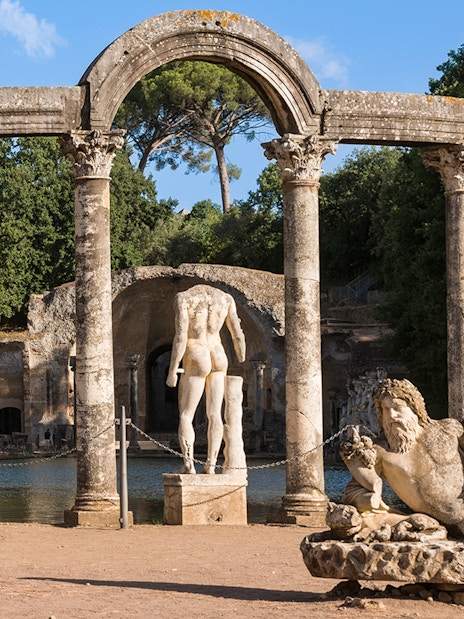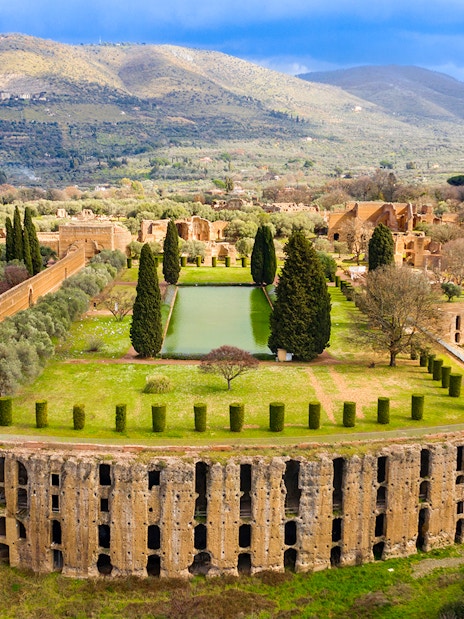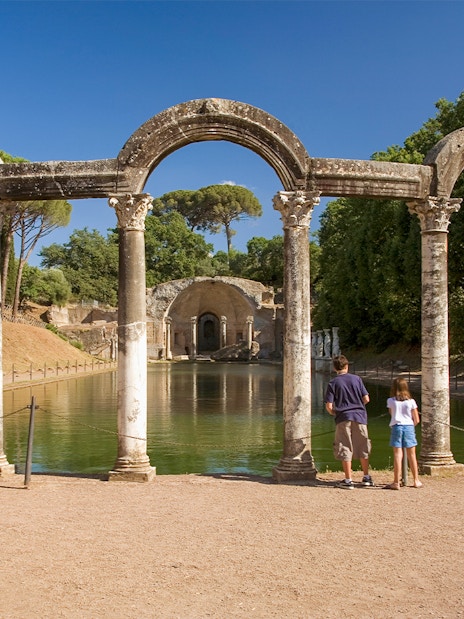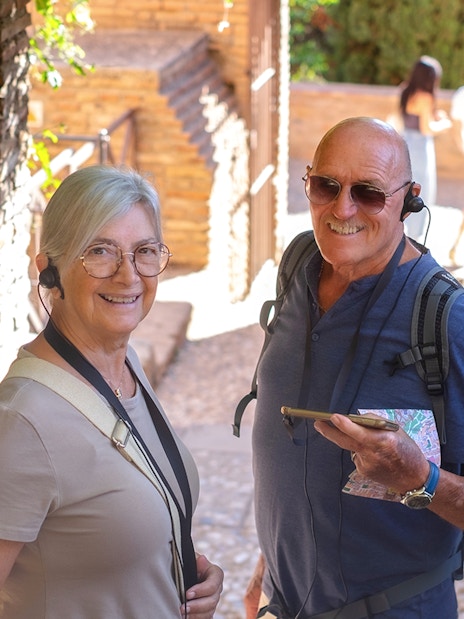Villa d'Este Tickets
Headout is an authorized and trusted partner of the venue, offering curated experiences to enjoy this attraction. This is not the venue's website.

Get ahead of the crowds and explore the ancient villa at your own pace.
- Breeze through long waiting queues with express entry to Villa d'Este, a 16th-century structure and UNESCO World Heritage Site.
- Enjoy garden views from the Apartments of the Cardinal before entering the bedroom which features a gilded coffered ceiling with the Este crest.
- Stop by the Hall of the Fountain to see a stunning wall fountain with seashells and glass, topped by the d'Este eagle and the ceiling fresco of the Synod of the Gods.
- Stroll through the alley between Oval Fountain and Rometta Fountain, where water from 300 spouts flows over marble pavements.
- Upgrade to enjoy a multilingual audio guide or skip-the-line access to Hadrian's villa, the emperor’s private retreat from the 2nd century.
Get ahead of the crowds and explore the ancient villa at your own pace.
- Breeze through long waiting queues with express entry to Villa d'Este, a 16th-century structure and UNESCO World Heritage Site.
- Enjoy garden views from the Apartments of the Cardinal before entering the bedroom which features a gilded coffered ceiling with the Este crest.
- Stop by the Hall of the Fountain to see a stunning wall fountain with seashells and glass, topped by the d'Este eagle and the ceiling fresco of the Synod of the Gods.
- Stroll through the alley between Oval Fountain and Rometta Fountain, where water from 300 spouts flows over marble pavements.
- Upgrade to enjoy a multilingual audio guide or skip-the-line access to Hadrian's villa, the emperor’s private retreat from the 2nd century.
Inclusions
- Skip-the-line entry to Villa d'Este
- Audio guide in Italian, English, German, Spanish & French (as per option selected)
- Skip-the-line entry to Hadrian's Villa (as per option selected)
Exclusions
- Transfers between the 2 sites
- Tip: To catch the water organ’s enchanting melodies, plan your visit accordingly. It activates every two hours from 10:30am on all days.
- Villa d'Este is partially accessible, but the sloped gardens can be challenging. Visitors with reduced mobility can use a dedicated lift to reach the garden from the Palazzo.
- Grotto of Diana, a Renaissance cave in Villa d'Este has reopened after 40 years of closure. However, entry to the grotto would be limited.
- Hadrian's Villa is partially accessible due to its size and ancient structure. Some areas have been made more accessible.
- Require special accommodations for your disability? You can contact the venues in advance and they'll try to assist you.
- These tickets can't be cancelled or rescheduled.
Reviews
How do we collect reviews?
Snapshots from our guests
3.7
42 ratings
16
12
4
4
6
What our guests say
Vojtech
May 2025Verified booking
Responsible price , nice museum, beautiful gardens
Merridith
May 2025Verified booking
The lines were moderate. We did not have to wait at all due to our advance ticket purchase. The gardens at the villa are beautiful it was a great day!
Patrice
Jul 2025Verified booking
Nothing special to report....
View original review in French
Luke
Jun 2025Verified booking
It was one of our highlights when staying in Rome. Absolutely beautiful. Luke Fischer
Luc
Jun 2025Verified booking
I find that skip the line is useless
Diane
Jun 2025Verified booking
Beautiful garden and location, too bad there was no audio guide or anything like that
View original review in Dutch
Tina
May 2025Verified booking
Rained but didn't stop us from enjoying beautiful scenery. Liked that it wasn't as crowded. Enjoyed the day a lot
Rebecca
Jun 2025Verified booking
Giuliano
Jun 2025Verified booking
Adrienne
Jun 2025Verified booking
Maryline
Jun 2025Verified booking
Werner
Jun 2025Verified booking
clive
Jun 2025Verified booking
CINZIA
Jun 2025Verified booking
Antonietta
Jun 2025Verified booking
Arturo
May 2025Verified booking
Adriano
May 2025Verified booking
Ornella
May 2025Verified booking
Rastoul
May 2025Verified booking
Angelo
May 2025Verified booking
Liat
May 2025Verified booking
Andreoli
May 2025Verified booking
Joanne
May 2025Verified booking
Simona
May 2025Verified booking
Gian
Apr 2025Verified booking
Visit two villas with one ticket, including all the perks of skip-the-line access, pre-booking, and direct entry.
- The ticket is valid for 3 days, so you can take your time exploring Tivoli's Villa d'Este, Hadrian's Villa, and the Sanctuary of Hercules.
- Jump past the queues and discover ruins of spas, temples, and an artificial lake at Emperor Hadrian's 2nd-century retreat.
- Stroll through the Renaissance gardens of Villa d'Este, admire the whimsical fountains, and take in countryside views from the terrace.
- At the Sanctuary of Hercules Victor, don't miss out on the ancient temple complex, amphitheater, and underground tunnel route.
Visit two villas with one ticket, including all the perks of skip-the-line access, pre-booking, and direct entry.
- The ticket is valid for 3 days, so you can take your time exploring Tivoli's Villa d'Este, Hadrian's Villa, and the Sanctuary of Hercules.
- Jump past the queues and discover ruins of spas, temples, and an artificial lake at Emperor Hadrian's 2nd-century retreat.
- Stroll through the Renaissance gardens of Villa d'Este, admire the whimsical fountains, and take in countryside views from the terrace.
- At the Sanctuary of Hercules Victor, don't miss out on the ancient temple complex, amphitheater, and underground tunnel route.
Inclusions
- 3-day pass to Hadrian's Villa, Villa d'Este, and the Sanctuary of Hercules Victor
- Skip-the-line access to Hadrian's Villa & Villa d'Este
- Access to ongoing exhibitions
- Audio guide in Italian, English, German, Spanish & French (as per option selected)
Exclusions
- Transfers between the 3 sites
- Tip: For the best sunset views at Villa d'Este, head to the Gran Loggia, located at the edge of the terrace.
- Villa d'Este is partially accessible, but the sloped gardens can be challenging. Visitors with reduced mobility can use a dedicated lift to reach the garden from the Palazzo.
- Grotto of Diana, a Renaissance cave in Villa d'Este has reopened after 40 years of closure. However, entry to the grotto shall be limited.
- Hadrian's Villa and the Sanctuary of Hercules Victor are partially accessible.
- Require special accommodations for your disability? You can contact the venues in advance and they will assist you.
- The pass is valid for 3 days from first use.
- These tickets can't be cancelled or rescheduled.
Reviews
How do we collect reviews?
Snapshots from our guests
4.1
20 ratings
9
6
3
1
1
What our guests say
Vojtech
May 2025Verified booking
Responsible price , nice museum, beautiful gardens
Patrice
Jul 2025Verified booking
Nothing special to report....
View original review in French
Luc
Jun 2025Verified booking
I find that skip the line is useless
Tina
May 2025Verified booking
Rained but didn't stop us from enjoying beautiful scenery. Liked that it wasn't as crowded. Enjoyed the day a lot
Rebecca
Jun 2025Verified booking
Adrienne
Jun 2025Verified booking
Werner
Jun 2025Verified booking
CINZIA
Jun 2025Verified booking
Arturo
May 2025Verified booking
Ornella
May 2025Verified booking
Andreoli
May 2025Verified booking
Joanne
May 2025Verified booking
Simona
May 2025Verified booking
STEFANO
Apr 2025Verified booking
Antonino
Apr 2025Verified booking
Stefano
May 2025Verified booking
The audio guide we had purchased in the package did not work on the second day we visited Villa D'Este. We report your failure to respond to the various messages sent to the support chat reporting the problem.
View original review in Italian
Massimiliano
Apr 2025Verified booking
The ticket was free that day
View original review in Italian
Dragan
Apr 2025Verified booking
..........................................
This review is translated. Show original review.
NADIA
Apr 2025Verified booking
Noelle
Mar 2025Verified booking
Itinerary
TOTAL DURATION7 hours
MODE OF TRANSFERA/C Bus
Timeline
Map
START POINT
Via Cavour building 224
Meet your guide at Via Cavour 224, in the heart of Rome's bustling Monti district.
33.1 km
48 minutes
1
Tivoli
3 attractions
Soak in the charm of Tivoli, a picturesque town known for its stunning villas and lush gardens, perfect for a relaxing exploration.
Things to do
1. Villa d'Este
Tickets included
Wander through Villa d'Este's spectacular Renaissance gardens, famous for its elaborate fountains and scenic views.
2. Tivoli Town
Stop by Tivoli’s charming town center, grab a quick meal, and look out for souvenirs at local shops.
3. Hadrian's Villa
Tickets included
Explore the sprawling ruins of Hadrian's Villa, where the remains of an emperor's private retreat offer a glimpse into ancient Roman opulence.
32.1 km
43 minutes
2
END POINT
Via Cavour building 224
Enjoy stress-free transfers and fast-track entry to Tivoli's Villa d'Este and Hadrian’s Villa!
- Embark on a day trip from Rome to Tivoli and soak in the historic town’s charm, a quick escape from the city's hustle and bustle.
- Ditch the stress of navigation with round-trip transfers in AC coaches, ensuring a smooth journey to your destination.
- Spend less time waiting and more time exploring Villa d'Este and Hadrian's Villa with convenient skip-the-line access.
- Stroll through the Renaissance gardens of Villa d'Este, known for its fountains and grottoes, and discover the archaeological complex of Hadrian’s Villa.
Enjoy stress-free transfers and fast-track entry to Tivoli's Villa d'Este and Hadrian’s Villa!
- Embark on a day trip from Rome to Tivoli and soak in the historic town’s charm, a quick escape from the city's hustle and bustle.
- Ditch the stress of navigation with round-trip transfers in AC coaches, ensuring a smooth journey to your destination.
- Spend less time waiting and more time exploring Villa d'Este and Hadrian's Villa with convenient skip-the-line access.
- Stroll through the Renaissance gardens of Villa d'Este, known for its fountains and grottoes, and discover the archaeological complex of Hadrian’s Villa.
Inclusions
- Half-day trip around Tivoli
- Skip-the-line entry to Villa d’Este and Hadrian's Villa
- Pick-up from Rome
- Round-trip AC coach transfers
Exclusions
- Hotel transfers
- Live guide
- This experience is not accessible by wheelchair and pram/strollers.
- Grotto of Diana, a Renaissance cave in Villa d'Este, has reopened after 40 years of closure. However, entry to the grotto is limited.
- These tickets can't be cancelled or rescheduled.
Jump the queues and tune into a multilingual audio guide at Tivoli’s stunning palace and garden.
- Avoid long ticket lines and explore the interiors and exterior of the UNESCO-listed Villa d’Este at your own pace.
- With an audio guide available in five languages, learn all about the Renaissance frescoes and fountains at this 16th-century villa.
- Take in panoramas from the terraces, and meander along charming paths lined with nymphs, ornaments, musical displays, and grottos.
Jump the queues and tune into a multilingual audio guide at Tivoli’s stunning palace and garden.
- Avoid long ticket lines and explore the interiors and exterior of the UNESCO-listed Villa d’Este at your own pace.
- With an audio guide available in five languages, learn all about the Renaissance frescoes and fountains at this 16th-century villa.
- Take in panoramas from the terraces, and meander along charming paths lined with nymphs, ornaments, musical displays, and grottos.
Inclusions
- Skip-the-line entry to Villa d’Este
- Audio guide in Italian, English, German, Spanish & French
Exclusions
- Headphones
- Grotto of Diana, a Renaissance cave in the villa, has reopened after 40 years of closure. However, entry to the grotto is limited.
- Villa d'Este is partially accessible, but the sloped gardens can be challenging. Visitors with reduced mobility can use a dedicated lift to reach the garden from the Palazzo.
- Require special accommodations for your disability? Contact the venue in advance and they'll try to assist you.
- These tickets can't be cancelled or rescheduled.
Reviews
How do we collect reviews?
Snapshots from our guests
4.1
25 ratings
11
9
3
1
1
What our guests say
Vojtech
May 2025Verified booking
Responsible price , nice museum, beautiful gardens
Patrice
Jul 2025Verified booking
Nothing special to report....
View original review in French
Luc
Jun 2025Verified booking
I find that skip the line is useless
Tina
May 2025Verified booking
Rained but didn't stop us from enjoying beautiful scenery. Liked that it wasn't as crowded. Enjoyed the day a lot
Rebecca
Jun 2025Verified booking
Adrienne
Jun 2025Verified booking
Clare
Jun 2025Verified booking
Werner
Jun 2025Verified booking
CINZIA
Jun 2025Verified booking
Arturo
May 2025Verified booking
Violeta
May 2025Verified booking
Ornella
May 2025Verified booking
CHIRON
May 2025Verified booking
Andreoli
May 2025Verified booking
Joanne
May 2025Verified booking
Tracey
May 2025Verified booking
Simona
May 2025Verified booking
STEFANO
Apr 2025Verified booking
Antonino
Apr 2025Verified booking
Stefano
May 2025Verified booking
The audio guide we had purchased in the package did not work on the second day we visited Villa D'Este. We report your failure to respond to the various messages sent to the support chat reporting the problem.
View original review in Italian
Bianchi
Jul 2025Verified booking
I paid for a service that I could not use. Although I downloaded the app and logged in, I could not access the audio guide
View original review in Italian
Massimiliano
Apr 2025Verified booking
The ticket was free that day
View original review in Italian
Dragan
Apr 2025Verified booking
..........................................
This review is translated. Show original review.
NADIA
Apr 2025Verified booking
Antoaneta
Mar 2025Verified booking
Villa D'Este Express Guided Tour
Entry to Villa d'Este, plus a guided tour of the gardens & fountains.
- Everything you get: Entry to Villa d’Este, a UNESCO World Heritage site. Your guide will share tales of Renaissance mythology as your roam the Cardinal's apartments and frescoed ceilings. Marvel at the 16th century engineered fountains without a pump and statues of Roman gods and goddesses.
- Why choose this: Get a guided tour of the villa with a small group of 10, ideal for history and art lovers interested in Renaissance art and hydraulic engineering.
Villa D'Este Express Guided Tour
Entry to Villa d'Este, plus a guided tour of the gardens & fountains.
- Everything you get: Entry to Villa d’Este, a UNESCO World Heritage site. Your guide will share tales of Renaissance mythology as your roam the Cardinal's apartments and frescoed ceilings. Marvel at the 16th century engineered fountains without a pump and statues of Roman gods and goddesses.
- Why choose this: Get a guided tour of the villa with a small group of 10, ideal for history and art lovers interested in Renaissance art and hydraulic engineering.
Inclusions
- Entry to Villa d’Este
- Expert english-speaking guide
- Headsets
Exclusions
NA
- Grotto of Diana, a Renaissance cave in the villa, has reopened after 40 years of closure. However, entry to the grotto is limited.
- This experience is not suitable for wheelchair users.
- Pets are not allowed inside.
- You can cancel these tickets up to 24 hours before the experience begins and get a full refund.
TivoliTivoli Villa d’Este
Why visit Villa d'Este in Tivoli?
A cardinal's Renaissance vision
A product of Cardinal Ippolito II d'Este’s love for luxury and Renaissance artworks, Tivoli’s Villa d’Este is a 400-year-old monastery-turned-mansion.
UNESCO World Heritage Site
Featuring over 500 fountains, water lilies, caves, and innovative hydraulic works, its gardens have inspired many European landscapes, believed to be modeled after the lost Gardens of Babylon.
Just one hour from Rome
This beautiful estate is perfect for a half-day trip from Rome along the countryside. Browse through a curation of the best ticket and tour options that ensure all the essentials for a perfect visit.
Which Villa d'este ticket is best for you?

Skip-the-line access
Best suited for: Travelers short on time, peak season visitors
Duration: Flexible
Guide: No
- Skip the long lines (especially during peak season) into Villa d'Este and maximize your exploration time. Select an audio guide for more context.
- Enjoy the flexibility to pick your slot, and explore Villa d'Este at your own pace, savoring the gardens, fountains, and interiors without feeling rushed by a tour group or held back by a slow-moving line.
Recommended tickets:
- Villa d’Este Skip-the-Line Tickets
- Villa d’Este Skip-the-Line Tickets with Audio Guide

Day trips
Best suited for: Traveling from Rome, seeking convenience, families
Duration: 5 hour
Guide: Yes
- Sit back and relax with round-trip AC minivan transfers from Rome. Enjoy an easy breezy journey with no navigation nightmares!
- Experience both Villa d'Este and Hadrian's Villa with priority access, ensuring you don't miss any highlights and the interesting stories behind them.
Recommended tickets:
- From Rome: Villa d'Este & Hadrian's Villa Guided Tour with Transfers
- From Rome: Villa d'Este & Hadrian's Villa Skip-the-Line Tickets with Transfers

Combo tickets
Best suited for: Budget-conscious travelers, history buffs
Duration: Flexible
Guide: No
- This combo ticket offers a discounted price compared to buying separate tickets, allowing you to explore both the UNESCO World Heritage Sites and the Sanctuary of Hercules Victor for great value. With a 3-day validity, you have the freedom to visit the attractions at your own pace.
- Skip the queues at both iconic villas and experience the grandeur of Renaissance elegance (Villa d'Este) alongside the fascinating ruins of a Roman emperor's retreat (Hadrian’s Villa).
Recommended tickets:
- Villa d'Este & Hadrian's Villa Skip-the-Line Tickets with 3 Days Validity
Top highlights of Villa d’Este




See all photos
Explore Villa d’Este’s Gardens
The Fountain of Pegasus
Start your garden tour at the highest point, the Fountain of Pegasus, where water begins its journey through the Villa’s intricate fountain system.
Know before you go to Villa d’Este
Timings
Location
Entrances
Facilities
Accessibility
Tips

- January 1 - March 30
Tuesday - Sunday: 8:45am–7:45pm; Monday: 2am–7:30pm; Last admission: 6:45pm - March 31 - September 15
Tuesday - Sunday: 8:15am–7:30pm; Monday: 2am–7:30pm; Last admission: 6:15pm - September 16 - December 31
Tuesday - Sunday: 8:45am–7:45pm; Monday: 2am–7:30pm; Last admission: 6:30pm - Closed on: Monday mornings, January 1, May 1, and December 25
Address: Piazza Trento, 5, 00019 Tivoli (RM), Italy
Getting there
- By train: Lines FL2, R, RV, FR2 Regional Rail-line
- Closest station: Tivoli Train Station, 1.1 km
- By bus: Lines COTRAL, VILLAE, 2, 3, 4C, 4D
Closest stop: Tivoli Bus Terminal or Piazza Garibaldi, 210 m away - By car: Autostrada A24, exit: Tivoli
While parking is available, it can be challenging. Public transport, taxis, or guided tours are the most recommended ways to reach Villa d'Este.
Duration from airport: 45.9 km (Rome Ciampino Airport)

- Main entrance: The primary entrance is located on Piazza Trento, next to the entrance of the Church of Santa-Maria Maggiore. It has a somewhat modern structure and design compared to the villa’s lavish and artistic interiors.
- Fun fact: In the past, visitors arrived at the bottom of the gardens and ascended step by step to the villa, viewing the fountains and statuary. The current door at the Piazza Trento entrance dates back to 1521, before the time of Ippolito d'Este, the Villa's commissioner.

- Restrooms
- Audio guides
- Gift shop
- Cafe
- Nearby parking available for €5 per day
- Lift available at ground level for mobility issues

- Elevators are available to take you from the street level to the upper levels of the garden.
- Enjoy a free electric car ride with a driver (reservation required).
- School visits are welcome with a reservation.
- Feel free to bring your furry friends! Dogs are welcome with leashes and a manure collection kit.

- Don't miss the hydraulic organ in the Fountain of the Organ, activated every 2 hours from 10:30am onwards. It's an incredible feat of 16th-century engineering that uses the villa's fountains to power a musical performance, making it a unique experience.
- For a special experience, visit the villa during a full moon night when the musical fountains are activated and lit up. The whole ambiance feels like a dream.
- The Villa d’Este is a massive complex. Wear comfortable sneakers, as there is a lot of walking and climbing. Carry sunscreen and a hat if you’re visiting in summer, and bring an umbrella and a raincoat if you’re visiting in winter.
- Allocate at least 3-3.5 hours to explore the villa's interiors, historic rooms, halls, underground, vast gardens, and 500 stunning fountains.
- A local shuttle connects Villa d'Este and Hadrian's Villa for visitors interested in seeing both.
Beyond Villa d’Este, Tivoli

Hadrian's Villa
Distance: 5.8 km
Hadrian's Villa, a UNESCO World Heritage Site, was Emperor Hadrian's lavish 2nd-century retreat with palaces, baths, and gardens.

Sanctuary of Hercules Victor
Distance: 1.7 km
A Roman complex built between the 2nd and 1st century BC that boasts an ancient temple, a portico, a theater, and industrial structures.

Villa Gregoriana
Distance: 700 m
Nestled by the Aniene River, Villa Gregoriana features lush green trails, the Great Waterfall, and ruins of ancient monuments.

Tivoli Town
Distance: 750 m
Saunter through the quaint streets, pop into local shops, and savor a meal at one of the many cozy restaurants in the town.
Frequently asked questions about Villa d’Este tickets
Are there different types of tickets available for Villa d’Este?
Yes, there are multiple ticket types to choose from— Skip-the-line tickets to avoid long waiting queues, a flexible 3-day pass to explore at your own pace, or guided tours for expert insights and convenient transfers.
Is there any significance to visiting Villa d’Este and Hadrian's Villa together?
Indeed! Visiting Villa d’Este and Hadrian's Villa together offers a unique opportunity to experience two contrasting yet complementary aspects of Italy's rich cultural heritage. Villa d'Este, with its lavish gardens and fountains, speaks to the artistic and architectural might of the 16th century, reflecting Cardinal Ippolito II d'Este’s elite taste. In contrast, Hadrian's Villa, or Villa Adriana, is a window to ancient Roman luxury and engineering from the 2nd century AD, built as Emperor Hadrian's retreat.
Is there a difference in price between online and on-site ticket purchases?
There could be a slight difference between digital and on-site tickets. The price point accounts for various factors like seasonal promotions, priority access, transfers, etc. Typically, online tickets may offer discounts or promotions, flexibility in planning your experience and saving time with priority access. On-site tickets might be at standard pricing and may require you to wait in line, especially during peak visiting hours.
How far in advance should I book my tickets to ensure availability?
It is recommended to book tickets at least 1-2 days in advance before your visit to ensure a hassle-free experience.
Are audio guides available, and do they cost extra?
Yes, audio guides are available at Villa d'Este in Tivoli, but they cost extra. The audio guides provide amazing explanations and enhance the visitor experience as you explore the villa and gardens.
What is the best time to visit Villa d’Este?
Considering the focal point of Villa d'Este is its gardens, spring is the perfect season to plan your visit, when the wisteria and jacaranda are in full bloom. Fall is equally charming, with vibrant displays of yellow and red colors everywhere. You can either plan for early morning or during evening hours.
Is it possible to upgrade my ticket to include a guided tour on the day of my visit?
Yes, it is possible to upgrade your Villa d'Este ticket to include a guided tour on the day of your visit. Just inquire at the information desk and they’d be able to help you.
Can I re-enter Villa d’Este on the same day with the same ticket?
No, you cannot re-enter Villa d'Este on the same day with the same ticket. The ticket is valid for a single entry only.
Is parking available, and do I need to reserve a spot in advance?
Parking is available near Villa d'Este in Tivoli, but you do not need to reserve a spot in advance.
What should I do if I lose my ticket or forget to bring it?
No worries! Just head to the ticket office or chat with the friendly staff at the villa entrance. They can help verify your purchase and guide you on what to do next. Remember to explain your situation clearly and have any relevant details handy, like your booking confirmation or ID, to make things easier. Enjoy your visit!

